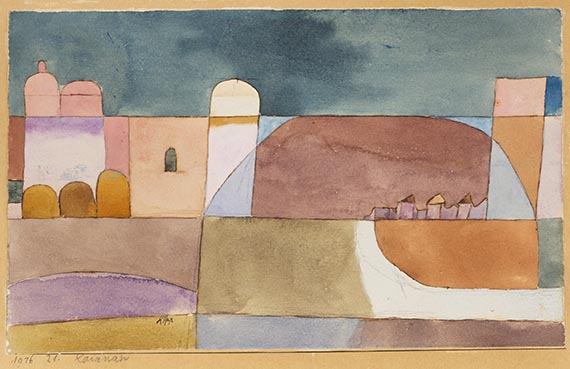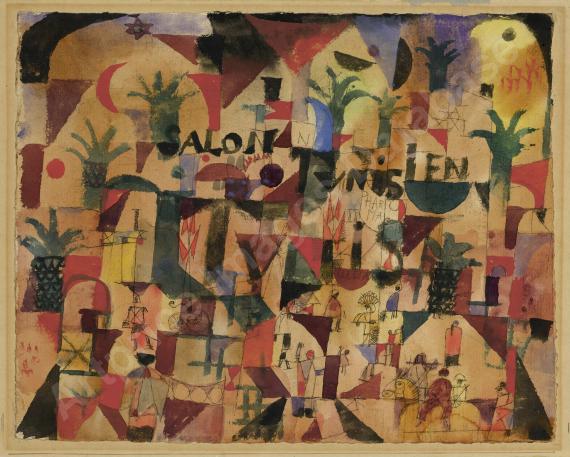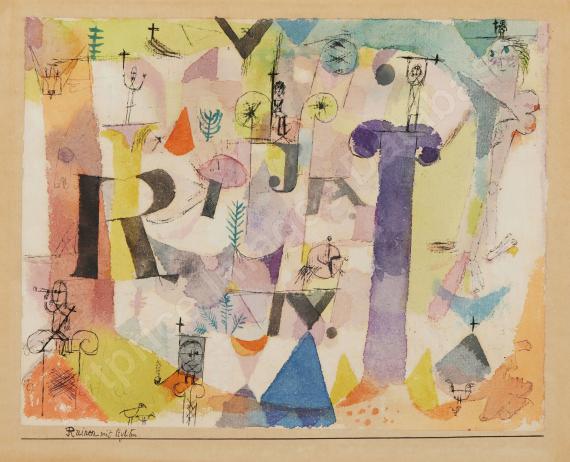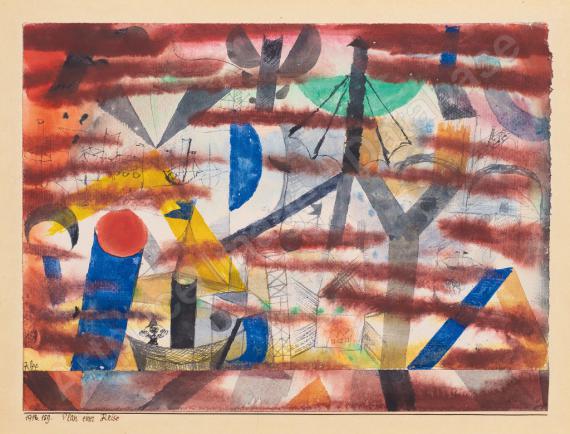77
Paul Klee
Kairuan (Kairuan mit den Kamelen und dem Esel), 1916.
Watercolor over pencil, originally laid on back...
Estimate:
€ 150,000 - 250,000
$ 174,000 - 290,000
Paul Klee
1879 - 1940
Kairuan (Kairuan mit den Kamelen und dem Esel). 1916.
Watercolor over pencil, originally laid on backing board.
Signed in the lower left. Dated on the original backing board in the lower left, titled “Kairuan” and inscribed with the work number “21.”. On laid paper, originally laid on backing board . 14.8 x 24 cm (5.8 x 9.4 in), the full sheet.
On his famous trip to Tunisia with August Macke and Morelet in the spring of 1914, Paul Klee experienced a pivotal moment in his artistic development.
• Kairouan – an important place of inspiration for Paul Klee's later work.
• A subtly balanced watercolor created in 1916 based on a sketch made during this trip to Tunisia (Kunstmuseum Bern).
• Significant provenance: Dr. Hans Koch Collection, Düsseldorf.
• Museum quality: exhibited several times in the 1920s and 1930s.
• Part of an important private collection in Berlin for over 40 years.
PROVENANCE: Hans Goltz, Munich (1921).
Collection of Dr. Hans Koch, Düsseldorf (from 1930 at the latest, until 1952).
Private collection, Baden-Württemberg (1952, inherited from the above, until 1956).
Galerie Grosshennig, Düsseldorf (acquired from the above in 1956: Stuttgarter Kunstkabinett).
Private collection, Baden-Württemberg (until 1984).
Private collection, Berlin (acquired from the above in 1984: Galerie Wolfgang Ketterer).
EXHIBITION: Kunstpalast, Düsseldorf (with an old label on the reverse).
Paul Klee, Galerie Alfred Flechtheim, Düsseldorf, February 15–March 10, 1930, cat. no. 45.
Paul Klee. Aquarelle aus 25 Jahren, 1905 bis 1930, Staatliches Museum, Saarbrücken, March 23–April 22, 1930, cat. no. 65.
Paul Klee, Kunstverein für die Rheinlande und Westfalen, Düsseldorf, June 14–July 6, 1931, cat. no. 107.
Paul Klee, August Macke, Galerie Alex Vömel, Düsseldorf, October 1–31, 1952, cat. no. 9.
LITERATURE: Paul Klee Foundation, Kunstmuseum Bern (ed.), Paul Klee. Catalogue raisonné. 1883-1940, 9 vols., Bern 1998-2003, vol. 2, CR no. 1618 ( illustrated in black and white).
- -
Stuttgarter Kunstkabinett, Stuttgart, 24th auction, May 29/30, 1956, lot 599 (illustrated in color).
Uta Gerlach-Laxner, Paul Klee und der Orient. Die Auswirkung auf sein Werk unter besonderer Berücksichtigung seiner Tunesienreise 1914, in: Die Tunisreise. Klee, Macke, Moilliet, Westfälisches Landesmuseum für Kunst und Kulturgeschichte, Münster, December 12, 1982–February 13, 1983; Städtisches Kunstmuseum, Bonn, March 9–April 24, 1983, p. 63.
Margareta Benz-Zauner, Werkanalytische Untersuchungen zu den Tunesien-Aquarellen Paul Klees, Frankfurt a.M. 1984, p. 181.
Galerie Wolfgang Ketterer, Munich, 87th auction, November 26–27, 1984, lot 800.
Wolfgang Kersten, Osamu Okuda, Paul Klee. Im Zeichen der Teilung, Düsseldorf 1995, p. 52 (illustrated on p. 52).
“That is the meaning of this happy hour: color and I are one. I am a painter.”
From Paul Klee's journal, April 16, 1914
Called up: December 5, 2025 - ca. 19.32 h +/- 20 min.
1879 - 1940
Kairuan (Kairuan mit den Kamelen und dem Esel). 1916.
Watercolor over pencil, originally laid on backing board.
Signed in the lower left. Dated on the original backing board in the lower left, titled “Kairuan” and inscribed with the work number “21.”. On laid paper, originally laid on backing board . 14.8 x 24 cm (5.8 x 9.4 in), the full sheet.
On his famous trip to Tunisia with August Macke and Morelet in the spring of 1914, Paul Klee experienced a pivotal moment in his artistic development.
• Kairouan – an important place of inspiration for Paul Klee's later work.
• A subtly balanced watercolor created in 1916 based on a sketch made during this trip to Tunisia (Kunstmuseum Bern).
• Significant provenance: Dr. Hans Koch Collection, Düsseldorf.
• Museum quality: exhibited several times in the 1920s and 1930s.
• Part of an important private collection in Berlin for over 40 years.
PROVENANCE: Hans Goltz, Munich (1921).
Collection of Dr. Hans Koch, Düsseldorf (from 1930 at the latest, until 1952).
Private collection, Baden-Württemberg (1952, inherited from the above, until 1956).
Galerie Grosshennig, Düsseldorf (acquired from the above in 1956: Stuttgarter Kunstkabinett).
Private collection, Baden-Württemberg (until 1984).
Private collection, Berlin (acquired from the above in 1984: Galerie Wolfgang Ketterer).
EXHIBITION: Kunstpalast, Düsseldorf (with an old label on the reverse).
Paul Klee, Galerie Alfred Flechtheim, Düsseldorf, February 15–March 10, 1930, cat. no. 45.
Paul Klee. Aquarelle aus 25 Jahren, 1905 bis 1930, Staatliches Museum, Saarbrücken, March 23–April 22, 1930, cat. no. 65.
Paul Klee, Kunstverein für die Rheinlande und Westfalen, Düsseldorf, June 14–July 6, 1931, cat. no. 107.
Paul Klee, August Macke, Galerie Alex Vömel, Düsseldorf, October 1–31, 1952, cat. no. 9.
LITERATURE: Paul Klee Foundation, Kunstmuseum Bern (ed.), Paul Klee. Catalogue raisonné. 1883-1940, 9 vols., Bern 1998-2003, vol. 2, CR no. 1618 ( illustrated in black and white).
- -
Stuttgarter Kunstkabinett, Stuttgart, 24th auction, May 29/30, 1956, lot 599 (illustrated in color).
Uta Gerlach-Laxner, Paul Klee und der Orient. Die Auswirkung auf sein Werk unter besonderer Berücksichtigung seiner Tunesienreise 1914, in: Die Tunisreise. Klee, Macke, Moilliet, Westfälisches Landesmuseum für Kunst und Kulturgeschichte, Münster, December 12, 1982–February 13, 1983; Städtisches Kunstmuseum, Bonn, March 9–April 24, 1983, p. 63.
Margareta Benz-Zauner, Werkanalytische Untersuchungen zu den Tunesien-Aquarellen Paul Klees, Frankfurt a.M. 1984, p. 181.
Galerie Wolfgang Ketterer, Munich, 87th auction, November 26–27, 1984, lot 800.
Wolfgang Kersten, Osamu Okuda, Paul Klee. Im Zeichen der Teilung, Düsseldorf 1995, p. 52 (illustrated on p. 52).
“That is the meaning of this happy hour: color and I are one. I am a painter.”
From Paul Klee's journal, April 16, 1914
Called up: December 5, 2025 - ca. 19.32 h +/- 20 min.
Paul Klee – The Tunis Trip of 1914
A small travel group made up of the painters Paul Klee, Louis Moilliet, and August Macke headed to Tunis in early April 1914. To this day, this trip is regarded as a turning point in art history, as it would significantly change the way European painters viewed color, light, and artistic perception.
Paul Klee had known Louis Moilliet since his school days, and they had also been friends as artists for years. Moilliet, in turn, had met August Macke and introduced them to each other. And so it happened that the three of them – each on an individual artistic quest – headed south. For Klee, who described himself with a certain ironic undertone as a “penniless family man,” the trip was only possible because the Bernese pharmacist Charles Bornand provided him with financial support. In return, Klee promised him ten drawings or five watercolors. In addition, Moilliet promised his friend Ernst Jäggi that he would paint the walls of his house in Saint-Germain near Tunis to supplement their shared travel funds.
First impressions of Tunis
Moilliet himself had already traveled to Tunisia several times in previous years and thus served as a kind of guide. Once again, their first destination was the home of Ernst Jäggi, who worked as the director of the military hospital in Tunis. From there, the three artists undertook numerous excursions: to Sidi Bou Said, Hammamet, Kairouan, and the suburb of Saint-Germain.
In his diaries, Klee describes his arrival in Tunis on April 7, 1914, after several days at sea from Marseille, with overwhelming clarity: “The sun with a dark power, colorful clarity on land – promising.” This first impression, a mixture of intense light, bright colors, and strangeness, left an indelible mark on him. He was also fascinated by the city itself, describing it as a “synthesis of urban planning and visual architecture.” From the very beginning, Macke and Klee sensed that this place would be fertile ground for their work.
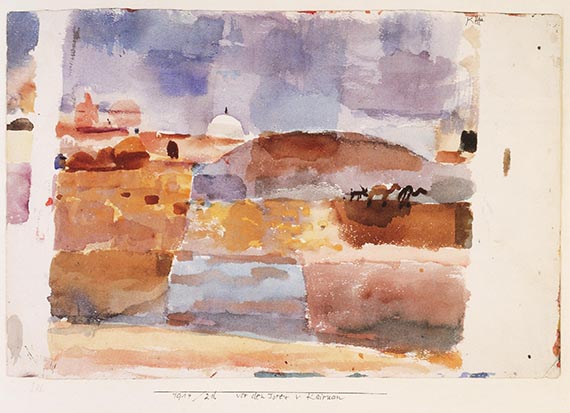
Light, color, and self-discovery
In his diaries, Klee recorded the journey in anecdotes, precise descriptions, and poetic reflections. He expected it to be a “study trip where one inspires the other.” Even the first evenings in Tunis and Saint-Germain overwhelmed him. On April 12, he noted: “The evening is incredible. To top it off, the full moon is rising […] Of course, I fail in the face of nature. But I know a little more than I did before. I know the distance between my failure and nature. That is an internal matter for the next few years. I am not at all depressed about it. There is no need to rush when there is so much you want. The evening is always so deep within me.”
These words mark a decisive point in Klee's artistic development. He is aware that he cannot immediately translate his experiences into art. Instead, he understands that the impressions of this journey need time to linger within him, to settle, to transform. He absorbs them like seeds that will continue to grow within him and bear fruit—not immediately, but in the years to come.
The breakthrough in Kairouan
The experience in Kairouan seems particularly impressive and almost mythical. It is here, it seems, that the long-awaited breakthrough occurred. Early in the morning, outside the city gates, Klee worked on a watercolor sketch. He described the moment as follows: "Painted early outside the city, slightly scattered light, mild and clear at the same time. No fog. It permeates me so deeply and gently, I feel it and become so sure, without effort. The color has me. I don't need to grasp for it. It has a hold of me forever, I know that. That is the meaning of this happy hour: I and the color are one: I am a painter."
This sentence – “I am a painter” – is considered one of Paul Klee's central self-revelations. Not that he hadn't painted before, but here, in Kairuan, he discovered the unity of perception, color, and inner expression. It was the moment when he saw his destiny confirmed.
From sketch to independent work
Upon his return to Germany, Klee devoted himself intensively to the sketches and studies he had made in Tunisia. He revisited many motifs over the following months and years, refining them. In doing so, it became clear how deeply the experiences of this trip had affected him.
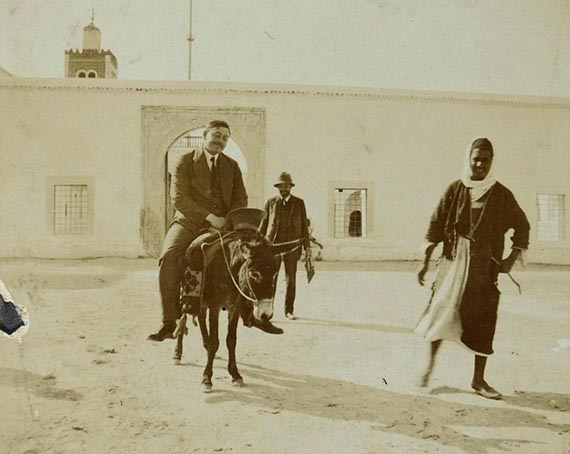
He also draws on the watercolor sketch “1914/216, Vor den Toren von Kairuan” (Before the Gates of Kairuan), today preserved in the Paul Klee Foundation at the Kunstmuseum Bern. For a long time, he did not consider this small sheet, which he painted directly on site, to be an independent work, but merely a study. It was not until 1921, that Klee began to appreciate such works as accomplished pieces in their own right. Until then, they were valuable starting points for him, sources that he continued to work on and transformed into other, more mature pictorial solutions.
Our watercolor from 1916 was created precisely in this process. Klee revisited the sketch he had made on site, but now condensed it into a clearly defined, concentrated work. While the sketch still features a vast foreground, he reduced it in the later sheet. He directs attention to what is essential for him: the striking domes of the city, clearly recognizable and yet undergoing a quiet transformation, and the small group of three camels that appear in the right-hand part of the picture under a large, brownish arch.
This concentration reveals the inner progress that Klee had achieved since 1914. The watercolor from 1916 is not merely a reproduction of an external reality, but the essence of an experience. The trip to Tunisia was more than a geographical adventure—it was a journey inward, a process of self-assurance. After two years, the overwhelming impression of light and color has become the quiet certainty of his own visual language.
Impact and significance
The watercolor is thus exemplary of Klee's approach: from the sketches he made during his travels, which were initially intended only as studies, he developed works of lasting clarity in hindsight. He was aware of the significance of this process. The “happy hour of Kairuan,” in which he felt at one with color, remained his orientation and inner gauge.
Hence, our sheet is not only a testimony to the legendary journey of three artists, but also a document of an artistic awakening. It combines the freshness of the immediate impression with the maturity of later contemplation. And it shows how Kairuan transformed Paul Klee into what he expressed in his own words: “I am a painter.” [EH]
A small travel group made up of the painters Paul Klee, Louis Moilliet, and August Macke headed to Tunis in early April 1914. To this day, this trip is regarded as a turning point in art history, as it would significantly change the way European painters viewed color, light, and artistic perception.
Paul Klee had known Louis Moilliet since his school days, and they had also been friends as artists for years. Moilliet, in turn, had met August Macke and introduced them to each other. And so it happened that the three of them – each on an individual artistic quest – headed south. For Klee, who described himself with a certain ironic undertone as a “penniless family man,” the trip was only possible because the Bernese pharmacist Charles Bornand provided him with financial support. In return, Klee promised him ten drawings or five watercolors. In addition, Moilliet promised his friend Ernst Jäggi that he would paint the walls of his house in Saint-Germain near Tunis to supplement their shared travel funds.
First impressions of Tunis
Moilliet himself had already traveled to Tunisia several times in previous years and thus served as a kind of guide. Once again, their first destination was the home of Ernst Jäggi, who worked as the director of the military hospital in Tunis. From there, the three artists undertook numerous excursions: to Sidi Bou Said, Hammamet, Kairouan, and the suburb of Saint-Germain.
In his diaries, Klee describes his arrival in Tunis on April 7, 1914, after several days at sea from Marseille, with overwhelming clarity: “The sun with a dark power, colorful clarity on land – promising.” This first impression, a mixture of intense light, bright colors, and strangeness, left an indelible mark on him. He was also fascinated by the city itself, describing it as a “synthesis of urban planning and visual architecture.” From the very beginning, Macke and Klee sensed that this place would be fertile ground for their work.

Paul Klee, Vor den Toren von Kairuan, 1914, watercolor, Kunstmuseum Bern/Paul-Klee-Stiftung.
Light, color, and self-discovery
In his diaries, Klee recorded the journey in anecdotes, precise descriptions, and poetic reflections. He expected it to be a “study trip where one inspires the other.” Even the first evenings in Tunis and Saint-Germain overwhelmed him. On April 12, he noted: “The evening is incredible. To top it off, the full moon is rising […] Of course, I fail in the face of nature. But I know a little more than I did before. I know the distance between my failure and nature. That is an internal matter for the next few years. I am not at all depressed about it. There is no need to rush when there is so much you want. The evening is always so deep within me.”
These words mark a decisive point in Klee's artistic development. He is aware that he cannot immediately translate his experiences into art. Instead, he understands that the impressions of this journey need time to linger within him, to settle, to transform. He absorbs them like seeds that will continue to grow within him and bear fruit—not immediately, but in the years to come.
The breakthrough in Kairouan
The experience in Kairouan seems particularly impressive and almost mythical. It is here, it seems, that the long-awaited breakthrough occurred. Early in the morning, outside the city gates, Klee worked on a watercolor sketch. He described the moment as follows: "Painted early outside the city, slightly scattered light, mild and clear at the same time. No fog. It permeates me so deeply and gently, I feel it and become so sure, without effort. The color has me. I don't need to grasp for it. It has a hold of me forever, I know that. That is the meaning of this happy hour: I and the color are one: I am a painter."
This sentence – “I am a painter” – is considered one of Paul Klee's central self-revelations. Not that he hadn't painted before, but here, in Kairuan, he discovered the unity of perception, color, and inner expression. It was the moment when he saw his destiny confirmed.
From sketch to independent work
Upon his return to Germany, Klee devoted himself intensively to the sketches and studies he had made in Tunisia. He revisited many motifs over the following months and years, refining them. In doing so, it became clear how deeply the experiences of this trip had affected him.

August Macke and Paul Klee in front of a mosque in Tunisia, 1914, collection Zentrum Paul Klee, Bern.
© HIP / Art Resource, NY
© HIP / Art Resource, NY
He also draws on the watercolor sketch “1914/216, Vor den Toren von Kairuan” (Before the Gates of Kairuan), today preserved in the Paul Klee Foundation at the Kunstmuseum Bern. For a long time, he did not consider this small sheet, which he painted directly on site, to be an independent work, but merely a study. It was not until 1921, that Klee began to appreciate such works as accomplished pieces in their own right. Until then, they were valuable starting points for him, sources that he continued to work on and transformed into other, more mature pictorial solutions.
Our watercolor from 1916 was created precisely in this process. Klee revisited the sketch he had made on site, but now condensed it into a clearly defined, concentrated work. While the sketch still features a vast foreground, he reduced it in the later sheet. He directs attention to what is essential for him: the striking domes of the city, clearly recognizable and yet undergoing a quiet transformation, and the small group of three camels that appear in the right-hand part of the picture under a large, brownish arch.
This concentration reveals the inner progress that Klee had achieved since 1914. The watercolor from 1916 is not merely a reproduction of an external reality, but the essence of an experience. The trip to Tunisia was more than a geographical adventure—it was a journey inward, a process of self-assurance. After two years, the overwhelming impression of light and color has become the quiet certainty of his own visual language.
Impact and significance
The watercolor is thus exemplary of Klee's approach: from the sketches he made during his travels, which were initially intended only as studies, he developed works of lasting clarity in hindsight. He was aware of the significance of this process. The “happy hour of Kairuan,” in which he felt at one with color, remained his orientation and inner gauge.
Hence, our sheet is not only a testimony to the legendary journey of three artists, but also a document of an artistic awakening. It combines the freshness of the immediate impression with the maturity of later contemplation. And it shows how Kairuan transformed Paul Klee into what he expressed in his own words: “I am a painter.” [EH]
77
Paul Klee
Kairuan (Kairuan mit den Kamelen und dem Esel), 1916.
Watercolor over pencil, originally laid on back...
Estimate:
€ 150,000 - 250,000
$ 174,000 - 290,000
Buyer's premium and taxation for Paul Klee "Kairuan (Kairuan mit den Kamelen und dem Esel)"
This lot can be purchased subject to differential or regular taxation.
Differential taxation:
Hammer price up to 1,000,000 €: herefrom 34 % premium.
The share of the hammer price exceeding 1,000,000 € is subject to a premium of 29 % and is added to the premium of the share of the hammer price up to 1,000,000 €.
The share of the hammer price exceeding 4,000,000 € is subject to a premium of 22 % and is added to the premium of the share of the hammer price up to 4,000,000 €.
The buyer's premium contains VAT, however, it is not shown.
Regular taxation:
Hammer price up to 1,000,000 €: herefrom 29 % premium.
The share of the hammer price exceeding 1,000,000 € is subject to a premium of 23% and is added to the premium of the share of the hammer price up to 1,000,000 €.
The share of the hammer price exceeding 4,000,000 € is subject to a premium of 15% and is added to the premium of the share of the hammer price up to 4,000,000 €.
The statutory VAT of currently 7 % is levied to the sum of hammer price and premium.
We kindly ask you to notify us before invoicing if you wish to be subject to regular taxation.
Differential taxation:
Hammer price up to 1,000,000 €: herefrom 34 % premium.
The share of the hammer price exceeding 1,000,000 € is subject to a premium of 29 % and is added to the premium of the share of the hammer price up to 1,000,000 €.
The share of the hammer price exceeding 4,000,000 € is subject to a premium of 22 % and is added to the premium of the share of the hammer price up to 4,000,000 €.
The buyer's premium contains VAT, however, it is not shown.
Regular taxation:
Hammer price up to 1,000,000 €: herefrom 29 % premium.
The share of the hammer price exceeding 1,000,000 € is subject to a premium of 23% and is added to the premium of the share of the hammer price up to 1,000,000 €.
The share of the hammer price exceeding 4,000,000 € is subject to a premium of 15% and is added to the premium of the share of the hammer price up to 4,000,000 €.
The statutory VAT of currently 7 % is levied to the sum of hammer price and premium.
We kindly ask you to notify us before invoicing if you wish to be subject to regular taxation.
Headquarters
Joseph-Wild-Str. 18
81829 Munich
Phone: +49 89 55 244-0
Fax: +49 89 55 244-177
info@kettererkunst.de
Louisa von Saucken / Undine Schleifer
Holstenwall 5
20355 Hamburg
Phone: +49 40 37 49 61-0
Fax: +49 40 37 49 61-66
infohamburg@kettererkunst.de
Dr. Simone Wiechers / Nane Schlage
Fasanenstr. 70
10719 Berlin
Phone: +49 30 88 67 53-63
Fax: +49 30 88 67 56-43
infoberlin@kettererkunst.de
Cordula Lichtenberg
Gertrudenstraße 24-28
50667 Cologne
Phone: +49 221 510 908-15
infokoeln@kettererkunst.de
Hessen
Rhineland-Palatinate
Miriam Heß
Phone: +49 62 21 58 80-038
Fax: +49 62 21 58 80-595
infoheidelberg@kettererkunst.de
We will inform you in time.




 Lot 77
Lot 77 